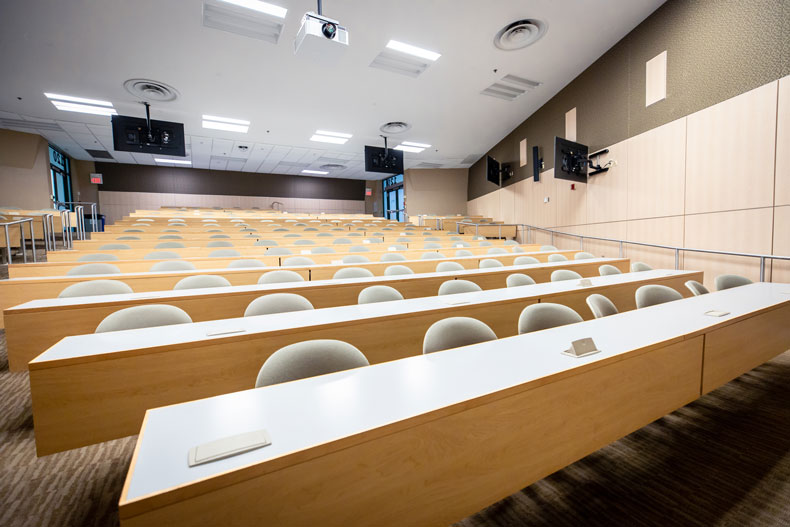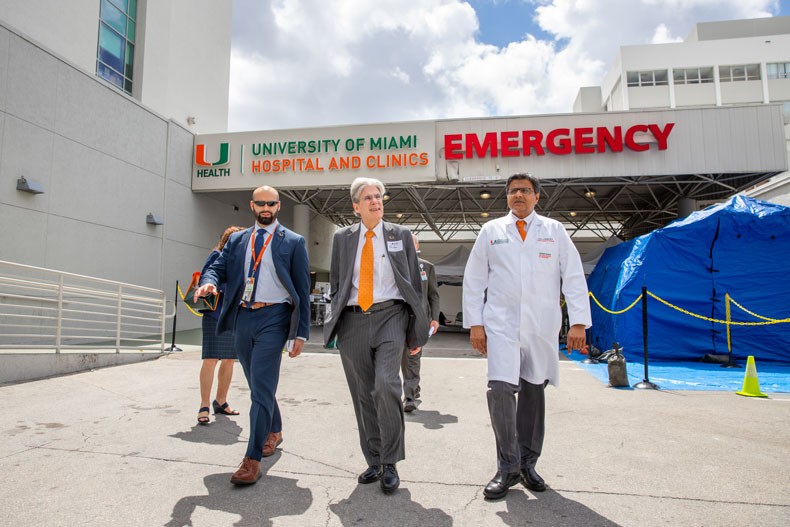From late summer to early winter, the cadence had always been regular and steady. But then, suddenly, the campus’s circadian rhythm was thrown out of kilter. Classrooms in every building sat empty. No students. No instructors. No group discussions. No experiments.
Walkways that connect a labyrinth of structures were devoid of foot traffic. Eateries in the massive food court were closed. And in a ballpark where 19- and 20-year-olds wielded bats and gloves to bag four College World Series titles and were poised to make a run at a fifth, the cheers went silent.
The COVID-19 pandemic that changed the world had turned the University of Miami almost into a ghost town, as school officials, like so many of their counterparts across the nation, made the painful but necessary decision to send students home for the rest of the academic term in an effort to halt the spread of the virus.
The University’s commencement exercises, academic rites of passage for thousands of graduates, were postponed. Students studying abroad were called home. Athletic competitions and other events were either canceled or put on hold. And, employees no longer commuted to the office but worked from home.
Still, the lectures, lessons, and learning continued—via Zoom, Skype, and on laptops and smartphones.
The changes occurred quickly—seemingly in the blink of an eye. It was the vision of a farsighted university president with a generation’s worth of know-how in responding to pandemics and a task force to support him that made things happen.
In truth, the University’s coronavirus response effort started before the decade even came to an end. When government officials in China reported in late December that health care workers were treating dozens of people in the central city of Wuhan for a mysterious pneumonia-like illness with symptoms that included fever, cough, difficulty breathing, and lung lesions, students were still on winter break, catching their breath after a months-long semester of studying and test taking.
Nearly 8,500 miles away in Coral Gables, University officials were keeping an eye on the outbreak, making response plans for the virus’s inevitable arrival in South Florida. By the time the first cases were confirmed in four states, the University was ready, rolling out its first advisory to the University community and launching a coronavirus response website—which grew to include everything from information and FAQs for students, faculty, and staff to prevention and well-being tips and a comprehensive list of resources.
The University didn’t go it alone. It partnered with Miami-Dade County and the state of Florida to monitor the crisis as it unfolded, and it followed guidelines from the Centers for Disease Control and Prevention and the World Health Organization when issuing health advisories to its community of students and employees.
President Julio Frenk, a former health minister of Mexico, also employed the power of media. In video messages to the University community, he became a calming and comforting voice in a time of crisis, providing updates on the institution’s latest actions to safeguard students and workers. In one communiqué, he even reminded everyone that it was “a time for preparation, precaution, and prudence—not panic.”
In his role as chair of the Miami-Dade Beacon Council’s One Community One Goal Academic Leaders Council, Frenk rallied other academic leaders. He met virtually with the presidents of other colleges and universities in the county to discuss ways to help the Greater Miami area amid the COVID-19 pandemic.
With more than 5,000 people participating in three virtual town halls held on March 31 and April 1, University leaders and medical experts answered questions and provided updates for faculty, staff, students, and their families on COVID-19 and its impact on the institution and the University of Miami health system.
The move to online learning
If there was any measure that demonstrated how swiftly and thoroughly University leadership responded to the crisis, it was their decision and ability to migrate courses to an online environment after students left for spring recess.
The University extended the semester break for a week, giving faculty time to prepare for online instruction, a process leadership helped facilitate by launching an academic and business continuity site. What normally would have taken weeks to pull off was done at breakneck speed. All told, faculty, with support from staff at the Distance Learning Institute, accomplished the transition—which required hours of training, the modification of courses and syllabi, and the translation of their teaching into digital platforms—in a week, a feat Jeffrey L. Duerk, executive vice president and provost, called an “extraordinary testament” to their hard work and dedication.
The tools and technology used in the conversion, said Duerk, will serve the University well into the future. “Some might say that this began when we started stepping up efforts to build a robust academic continuity infrastructure following Hurricane Irma,” said Duerk. “Few of us were thinking of a quickly spreading global pandemic; yet, hurricane or pandemic, the ramifications of our efforts will continue to ripple through not only higher education but all areas of our lives in unforeseen ways.”

Health care response
From rapid diagnostic tests to potential vaccines, researchers at the University of Miami Miller School of Medicine took up the battle against COVID-19 in their labs, with Natasa Strbo helping to lead the way. The assistant professor of microbiology and immunology enlisted the cancer and infectious disease vaccine she has worked on for more than decade in the fight against the virus.
“As soon as I heard that something pretty bad was happening in China, I was excited to investigate the potential of our vaccine, which is a really different approach. It’s based on a natural protein, gp96, that is present in our cells and activates immune responses,” said Strbo, whose team is working on the COVID-19 vaccine with Heat Biologics, the biopharmaceutical company that now owns the gp96 platform she helped develop. “We already have tremendous knowledge from our previous vaccine studies, so I think the gp96 platform has a lot of potential in inducing a protective immunity against COVID-19.”
Meanwhile, Miller School biomedical researchers, in collaboration with Heat Biologics, were involved in efforts to develop a rapid diagnostic test for the virus. The patient-friendly test, developed by Sylvia Daunert, chair of the Department of Biochemistry and Molecular Biology, and her colleagues, requires a simple pharyngeal throat swab to deliver on-the-spot results on a paper strip in less than 30 minutes.
“Our lab has tremendous experience developing accurate and easily usable tests for infectious diseases such as HPV and Zika,” said Daunert.
Another researcher, assistant professor of medicine Mark Sharkey, also worked to develop a diagnostic test for the coronavirus that would produce results just as quickly, but in a lab. “It’s based on fluorescence,” said Sharkey, “so after the sample is amplified, if it’s positive it will glow green in the reaction tube when a blue light shines on it.”
On the frontlines of the COVID-19 pandemic, University of Miami health care workers instituted their own measures to keep the spread of the virus in check. Teams of masked nurses, patient and visitor services staff, graduate students, and faculty from the School of Nursing and Health Studies, for example, questioned every person entering the 560-bed UHealth Tower, its emergency department, and other health care facilities about their recent travel history and coronavirus symptoms.
UM’s health care heroes have also treated those diagnosed with the virus, with one physician using a new therapy that has the potential to delay the need for a ventilator. Roger Alvarez, a pulmonologist with the University of Miami Health System and Miller School, began treating a COVID-19 patient in late March, using a nitric oxide system called INOpulse that had been recently approved by the FDA for treating coronavirus patients.
“The cardiopulmonary benefit demonstrated by INOpulse in various indications provides the potential to prevent deterioration in patients with COVID-19, allowing ventilators to be preserved for the most critically ill,” explained Alvarez, referring to the system developed by Warren, New Jersey-based Bellerophon Therapeutics, Inc.

When the cheering stopped
Miami’s storied athletic squads saw their seasons end abruptly when the NCAA canceled all winter and spring sports, the announcement forcing two Hurricanes teams—track & field and baseball—to return home even as they were on the road preparing for competition.
“It was a surreal scene all around. We felt the anguish that our student-athletes and coaches felt, and particularly empathized with our seniors and those teams who were working so hard to compete for conference and national championships,” Blake James, director of athletics, said in a statement to fans, noting that his department was working tirelessly to provide virtual support to student-athletes for academics, nutrition, training, career development, and mental and physical health.
“The games might be gone for the time being,” he said, “but our devotion remains steadfast.”
‘We will get through this’
The pandemic isn’t the first challenge the University has faced. The first class of 646 full-time students enrolled at the University in the fall of 1926 when the South Florida land boom had already collapsed and just days after a major hurricane devastated the area. And, in August of 1992, Hurricane Andrew hit the city, damaging buildings on the Coral Gables campus and delaying the start of classes.
In both instances, the institution recovered. So, too, will the University recover from the COVID-19 pandemic, Frenk said.
But there is a lesson that the nation—indeed, the world—needs to learn from the current crisis, he said.
“We will get through this, just as we’ve gotten through every pandemic,” he said. “But once we get through it, we would be foolish to assume that this was the last one. There will be another one; and if we let our guard down, we will again incur the same disruption and cost we are suffering now.
“We owe it to everyone who is undergoing the sacrifices and to all the people who will have died, not to relinquish our responsibility, and to keep the necessary investments and the capability around the world up to the level of the challenge,” Frenk pointed out. “This is a challenge that we can face. We have the tools. It will be faced successfully. I am very confident, thanks to science.”

